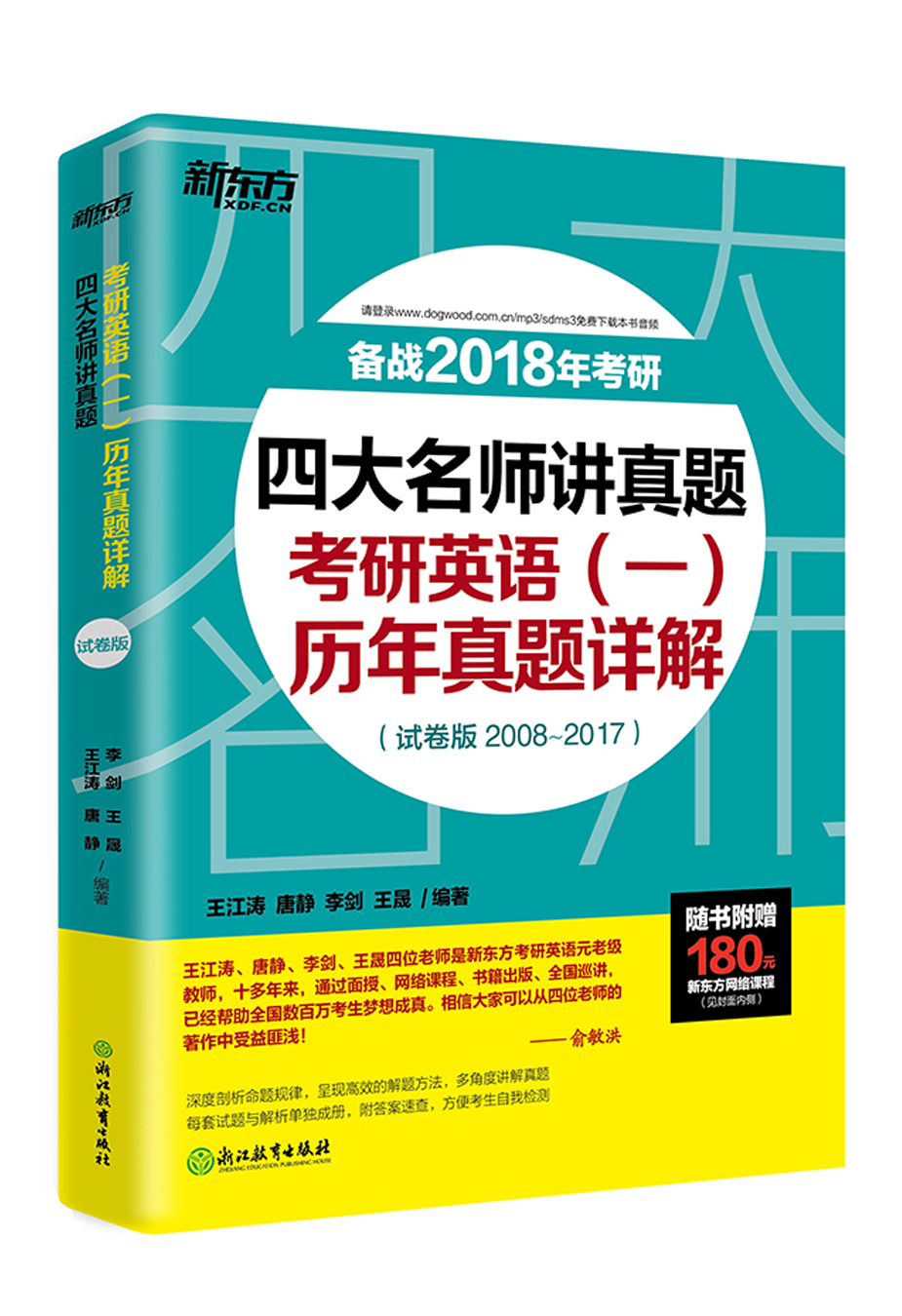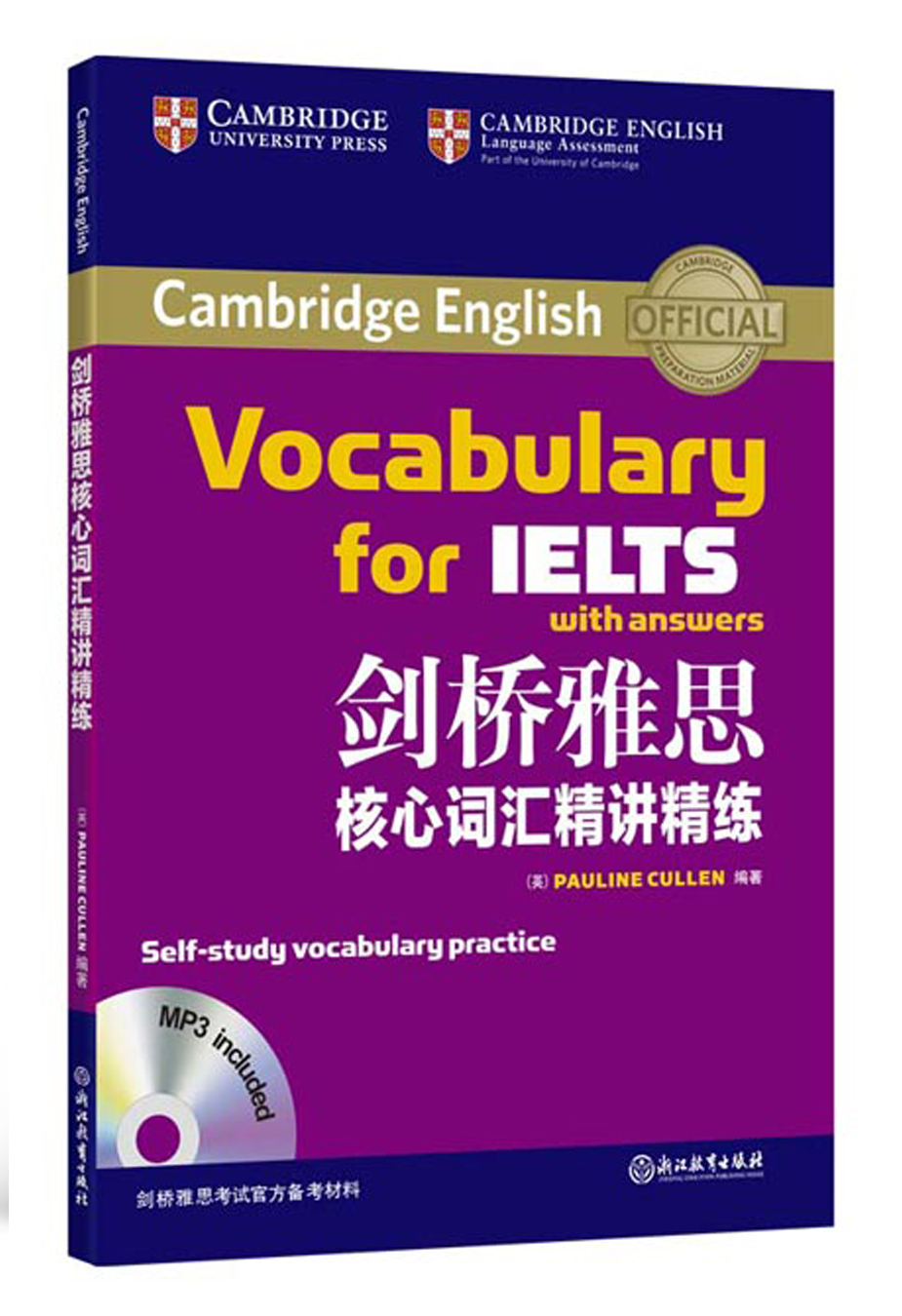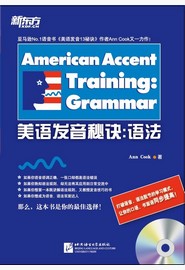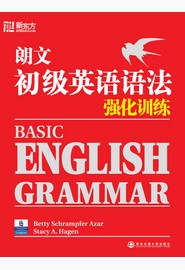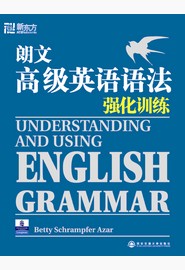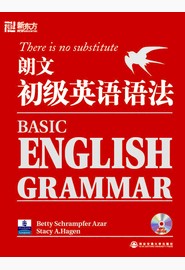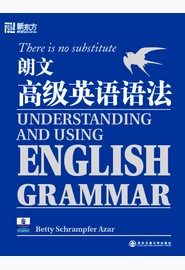朗文中级英语语法强化训练
其它购书方式: 新东方书友会邮购
读者,您好!如遇到音频无法下载的情况,请您及时与我们的维护人员联系,联系电话:62605588-188。
相关图书
编辑推荐
《朗文英语语法》系列是专门为英语学习者量身定做的一套语法教材,分为初级、中级、高级三个级别,并配有对应的强化训练册。该系列教材自20世纪80年代出版以来,深受广大英语学习者喜爱,在国际上享有盛誉。
《朗文中级英语语法强化训练》是《朗文中级英语语法》的配套练习册,它针对《朗文中级英语语法》各章节中的重要语法点设计了丰富、多样的练习,为学习者提供了大量在真实语境中练习运用语法规则的机会,使学习者能够通过循序渐进的学习,逐步提高准确、独立、创造性地运用语法知识进行交际实践的能力。
本练习册不仅可以满足学生自学英语语法的要求,也可以作为教辅材料,用于课堂教学、家庭作业、考试和课堂辅导。
译序:
作为世界上最畅销的英语语法教材之一,《朗文英语语法》系列教材在培养中国学生的英语实际应用能力方面,开创了一个全新的视野和学习思路。
许多在国外畅销的语法教材,来到国内都面临着叫好不叫座的尴尬。究其原因,主要是因为国内的英语课堂教学模式使大部分学生对语法的认识停留在课堂笔记中,对语法的应用止步于单项选择题。随之而来的是,语法既是学生的强项,同时又成了一大弊病—太多的条条框框成为阻碍学生自由表达的桎梏,缺乏输出方面的引导和有效的训练使得英语语法的诸多细则无法被“盘活”。久而久之,学生的英语思维越来越僵化,在以交流为导向的国外主流语言教材面前变得无所适从。所以,一套好的语法教材,不仅应该能够简单扼要、提纲挈领地讲解语法规则,而且要能够将语法知识与其在真实语言环境中的实际应用紧密地结合起来,让学生真正体会到语法学习的成就感和趣味性,就这一点来说,《朗文英语语法》系列带给我们许多有益的启示。
首先,这套教材根据不同级别的学生的水平和需求,对纷繁复杂的英语语法点进行了合理的梳理和编排,使学生可以结合自己的实际情况循序渐进地轻松掌握语法知识。其次,对语法规则的叙述和讲解可读性极强,通俗易懂,学起来不会让人感到枯燥乏味。再次,每个语法点都配备了形式多样的练习,这些练习均源自一个朴素的教学理念,即“应用和沟通是语言学习的最终目的”。通过这些基于真实语境的练习,学生可以在实际应用中不断加深对语法规则的记忆和理解,学习效率也会随之大大提高。
另外,这套教材的每个级别都配有对应的强化训练册。建议大家对练习的内容要力争做到熟读、口头复述甚至改写,这种看似单调的训练方法却是最直接有效的,可以帮助大家从认知到模仿,直至最后能够诠释自己的生活,在有效重复中逐渐完成从量变到质变,最终体会语言应用的最高境界,即语感(linguistic intuition)。
美国人说:“Use the word three times, and it’s yours.”我们始终坚信,英语语法不是“学”出来的,而是“用”出来的。希望大家在语法学习中也能化被动接受为主动表达,在反复的练习中体会把枯燥的语言规则转化为自如交流的快乐!
译者
于北京新东方学校
前言:
《朗文中级英语语法》(Fundamentals of English Grammar)是一本专门为中级水平的英语学习者提高语法技能而量身定做的教材。本书以语法为核心,同时通过各种方法帮助学习者全面提升各项语言技能。本书既可以用作课堂教材,也可以作为参考资料供学生自学。
和以往的版本相比,第三版不仅保留了折衷教学法(eclectic approach)和大量多样的练习,而且在多个方面进行了充实:
●进一步扩充了交流方面的内容,且表述得更加清晰、明确。教材中有大量“真实交 流”的机会供教师利用。这些内容以学生的生活经历为语言环境,从中选取有趣的话题,激励学生通过有组织的开放式讨论来自由地表达自己的观点。设置这种活动主要是基于很多经验丰富的教师们的观点,即以语法为基础的学习与通过口语交流来学习不是相互排斥的,而是相互促进的,这两种方式可以在同一个语言教程中、同一个班上,甚至同一节课上一起使用并且能够相互促进。
●更加注重互动性。第三版教材将许多以前标有“口语”或“口语(合上书)”的内容,重新编排成更容易操作的两人练习或小组练习。当然,在教师的带领下也可以进行全班练习。第三版教材鼓励互动,同时也给使用者留出了足够的空间,让其自行决定什么程度的互动最适合他们的需要。
●练习的种类更加丰富。第三版教材增加了自由回答练习和开放式交流任务,依旧提供大量控制性练习题,以加深学生对要学习的语法结构的形式、意义和用法的最初理解。同时,还包括了更多的写作话题、口语活动、错误分析练习和情景扩展练习。
●篇幅较长的章节已经被拆分成了较短的章节,某些语法单元也进行了重新编排。
《朗文中级英语语法强化训练》是《朗文中级英语语法》的配套练习册,它针对《朗文中级英语语法》中各章节的重要语法点设计了广泛而多样的练习,为各层次的学习者提供了丰富而实用的实践机会。而且它强调学习语法知识的同时,也注重其他各种语言技能的提高,使学生通过逐步学习语法知识提高自身正确、有效使用英语的能力。
此练习册的内容和设计不仅满足了学生自学英语语法的要求,而且也可以作为教师的辅助材料,用于课堂教学、家庭作业、考试和课堂辅导。
第三版教材封面上有一只展翅高飞的燕子。在世界各地都能看到燕子的身影,它们是快乐、顽皮、生机勃勃的鸟儿,它们的来去往往预示着季节的转换。这只燕子标志着新的开始——学生、教师和教材的编者携手并进,踏上新的语言学习之路。
《朗文中级英语语法强化训练》是《朗文中级英语语法》的配套练习册,它针对《朗文中级英语语法》各章节中的重要语法点设计了丰富、多样的练习,为学习者提供了大量在真实语境中练习运用语法规则的机会,使学习者能够通过循序渐进的学习,逐步提高准确、独立、创造性地运用语法知识进行交际实践的能力。
本练习册不仅可以满足学生自学英语语法的要求,也可以作为教辅材料,用于课堂教学、家庭作业、考试和课堂辅导。
译序:
作为世界上最畅销的英语语法教材之一,《朗文英语语法》系列教材在培养中国学生的英语实际应用能力方面,开创了一个全新的视野和学习思路。
许多在国外畅销的语法教材,来到国内都面临着叫好不叫座的尴尬。究其原因,主要是因为国内的英语课堂教学模式使大部分学生对语法的认识停留在课堂笔记中,对语法的应用止步于单项选择题。随之而来的是,语法既是学生的强项,同时又成了一大弊病—太多的条条框框成为阻碍学生自由表达的桎梏,缺乏输出方面的引导和有效的训练使得英语语法的诸多细则无法被“盘活”。久而久之,学生的英语思维越来越僵化,在以交流为导向的国外主流语言教材面前变得无所适从。所以,一套好的语法教材,不仅应该能够简单扼要、提纲挈领地讲解语法规则,而且要能够将语法知识与其在真实语言环境中的实际应用紧密地结合起来,让学生真正体会到语法学习的成就感和趣味性,就这一点来说,《朗文英语语法》系列带给我们许多有益的启示。
首先,这套教材根据不同级别的学生的水平和需求,对纷繁复杂的英语语法点进行了合理的梳理和编排,使学生可以结合自己的实际情况循序渐进地轻松掌握语法知识。其次,对语法规则的叙述和讲解可读性极强,通俗易懂,学起来不会让人感到枯燥乏味。再次,每个语法点都配备了形式多样的练习,这些练习均源自一个朴素的教学理念,即“应用和沟通是语言学习的最终目的”。通过这些基于真实语境的练习,学生可以在实际应用中不断加深对语法规则的记忆和理解,学习效率也会随之大大提高。
另外,这套教材的每个级别都配有对应的强化训练册。建议大家对练习的内容要力争做到熟读、口头复述甚至改写,这种看似单调的训练方法却是最直接有效的,可以帮助大家从认知到模仿,直至最后能够诠释自己的生活,在有效重复中逐渐完成从量变到质变,最终体会语言应用的最高境界,即语感(linguistic intuition)。
美国人说:“Use the word three times, and it’s yours.”我们始终坚信,英语语法不是“学”出来的,而是“用”出来的。希望大家在语法学习中也能化被动接受为主动表达,在反复的练习中体会把枯燥的语言规则转化为自如交流的快乐!
译者
于北京新东方学校
前言:
《朗文中级英语语法》(Fundamentals of English Grammar)是一本专门为中级水平的英语学习者提高语法技能而量身定做的教材。本书以语法为核心,同时通过各种方法帮助学习者全面提升各项语言技能。本书既可以用作课堂教材,也可以作为参考资料供学生自学。
和以往的版本相比,第三版不仅保留了折衷教学法(eclectic approach)和大量多样的练习,而且在多个方面进行了充实:
●进一步扩充了交流方面的内容,且表述得更加清晰、明确。教材中有大量“真实交 流”的机会供教师利用。这些内容以学生的生活经历为语言环境,从中选取有趣的话题,激励学生通过有组织的开放式讨论来自由地表达自己的观点。设置这种活动主要是基于很多经验丰富的教师们的观点,即以语法为基础的学习与通过口语交流来学习不是相互排斥的,而是相互促进的,这两种方式可以在同一个语言教程中、同一个班上,甚至同一节课上一起使用并且能够相互促进。
●更加注重互动性。第三版教材将许多以前标有“口语”或“口语(合上书)”的内容,重新编排成更容易操作的两人练习或小组练习。当然,在教师的带领下也可以进行全班练习。第三版教材鼓励互动,同时也给使用者留出了足够的空间,让其自行决定什么程度的互动最适合他们的需要。
●练习的种类更加丰富。第三版教材增加了自由回答练习和开放式交流任务,依旧提供大量控制性练习题,以加深学生对要学习的语法结构的形式、意义和用法的最初理解。同时,还包括了更多的写作话题、口语活动、错误分析练习和情景扩展练习。
●篇幅较长的章节已经被拆分成了较短的章节,某些语法单元也进行了重新编排。
《朗文中级英语语法强化训练》是《朗文中级英语语法》的配套练习册,它针对《朗文中级英语语法》中各章节的重要语法点设计了广泛而多样的练习,为各层次的学习者提供了丰富而实用的实践机会。而且它强调学习语法知识的同时,也注重其他各种语言技能的提高,使学生通过逐步学习语法知识提高自身正确、有效使用英语的能力。
此练习册的内容和设计不仅满足了学生自学英语语法的要求,而且也可以作为教师的辅助材料,用于课堂教学、家庭作业、考试和课堂辅导。
第三版教材封面上有一只展翅高飞的燕子。在世界各地都能看到燕子的身影,它们是快乐、顽皮、生机勃勃的鸟儿,它们的来去往往预示着季节的转换。这只燕子标志着新的开始——学生、教师和教材的编者携手并进,踏上新的语言学习之路。
作者简介
Betty Schrampfer Azar ——
从事英语语言教学研究和语法教材编写工作四十余年,对英语语法体系及语法教学有深入的研究和独到的见解,出版过多部经典语法教材。
从事英语语言教学研究和语法教材编写工作四十余年,对英语语法体系及语法教学有深入的研究和独到的见解,出版过多部经典语法教材。
图书目录
第一章 现在时 (PRESENT TIME)
1. 问答 (Interview Questions and Answers) 1
2. 现在时动词 (Present Verbs) 2
3. 一般现在时的形式 (Forms of the Simple Present) 2
4. 现在进行时的形式 (Forms of the Present Progressive) 3
5. 现在时动词:疑问句 (Present Verbs: Questions) 3
6. 现在时动词:疑问句 (Present Verbs: Questions) 4
7. 一般现在时 (Simple Present) 4
8. 一般现在时与现在进行时 (Simple Present and Present Progressive) 5
9. 一般现在时 (Simple Present) 5
10. 一般现在时与现在进行时 (Simple Present and Present Progressive) 6
11. 频度副词 (Frequency Adverbs) 7
12. 频度副词 (Frequency Adverbs) 7
13. 频度副词 (Frequency Adverbs) 8
14. 频度副词 (Frequency Adverbs) 8
15. 频度副词 (Frequency Adverbs) 9
16. 一般现在时:-s/-es结尾 (Simple Present: Final -s/-es) 10
17. 一般现在时:-s/-es结尾 (Simple Present: Final -s/-es) 11
18. -s/-es结尾的发音 (Pronunciation: Final -s/-es) 11
19. -s/-es结尾的发音 (Pronunciation: Final -s/-es) 12
20. -s/-es结尾的拼写 (Spelling: Final -s/-es) 12
21. 非行为动词 (Non-action Verbs) 12
22. 一般现在时与现在进行时 (Simple Present and Present Progressive) 13
23. 一般现在时与现在进行时 (Simple Present and Present Progressive) 14
24. 错误分析 (Error Analysis) 15
25. 现在时动词:疑问句和简略回答 (Present Verbs: Questions and Short Answers) 15
26. 复习:现在时动词 (Review: Present Verbs) 16
第二章 过去时 (PAST TIME)
1. 一般过去时 (Simple Past) 18
2. 一般过去时:规则动词与不规则动词 (Simple Past: Regular and Irregular Verb) 19
3. 一般过去时形式 (Simple Past Forms) 19
4. 现在时和过去时的否定句 (Present and Past Negatives) 20
5. 一般过去时:疑问句 (Simple Past: Questions) 21
6. 一般过去时:疑问句 (Simple Past: Questions) 21
7. 一般过去时:规则动词与不规则动词 (Simple Past: Regular and Irregular Verbs) 22
8. 规则动词:-ed结尾的发音 (Regular Verbs: Pronunciation of -ed Endings) 23
9. 规则动词:-ed结尾的发音 (Regular Verbs: Pronunciation of -ed Endings) 23
10. -ed结尾的发音和拼写 (Spelling and Pronunciation of -ed Endings) 23
11. 规则动词:-ed结尾的发音 (Regular Verbs: Pronunciation of -ed Endings) 24
12. -ing和-ed形式的拼写 (Spelling of -ing and -ed Forms) 24
13. -ing形式的拼写 (Spelling of -ing) 25
14. -ing和-ed形式的拼写 (Spelling of -ing and -ed) 25
15. -ing形式的拼写 (Spelling of -ing) 26
16. 不规则动词的拼写 (Spelling of Irregular Verbs) 27
17. 不规则动词 (Irregular Verbs) 28
18. 不规则动词 (Irregular Verbs) 29
19. 复习:过去时的疑问句和否定句 (Review: Past Questions and Negatives) 30
20. 一般现在时与一般过去时:疑问句 (Simple Present and Past: Questions) 31
21. 复习:一般现在时、现在进行时和一般过去时的形式
(Review: Simple Present, Present Progressive, Simple Past Forms) 32
22. 一般现在时与一般过去时 (Simple Present and Simple Past) 32
23. 过去进行时 (Past Progressive) 34
24. 过去进行时 (Past Progressive) 34
25. 过去进行时与一般过去时的比较 (Past Progressive vs. Simple Past) 35
26. 表示过去:使用时间从句 (Past Time Using Time Clauses) 36
27. 过去时动词 (Past Verbs) 37
28. 表示过去习惯:used to (Past Habit with used to) 39
29. 错误分析 (Error Analysis) 40
30. 过去时动词 (Past Verbs) 41
第三章 将来时 (FUTURE TIME)
1. 现在、过去和将来 (Present, Past, and Future) 43
2. will和be going to (will and be going to) 44
3. be going to 44
4. will 44
5. 带will和be going to的疑问句 (Questions with will and be going to) 45
6. will 46
7. will probably 46
8. will probably 47
9. 将来的确定性 (Sureness about the Future) 47
10. 将来的确定性 (Sureness about the Future) 48
11. will 49
12. be going to 与will 的比较 (be going to vs. will ) 49
13. be going to 与will 的比较 (be going to vs. will) 50
14. 过去和将来时间从句 (Past and Future Time Clauses) 52
15. 将来时间从句 (Future Time Clauses) 52
16. if从句 (if-clauses) 53
17. 时间从句和if从句 (Time Clauses and if-clauses) 54
18. 复习:过去和将来 (Review: Past and Future) 54
第四章 现在完成时与过去完成时 (THE PRESENT PERFECT AND THE PAST PERFECT)
1. 现在完成时的形式 (Forms of the Present Perfect) 64
2. 现在完成时 (The Present Perfect) 65
3. 复习:不规则动词 (Review: Irregular Verbs) 66
4. 现在完成时 (The Present Perfect) 67
5. 现在完成时与一般过去时的比较 (The Present Perfect vs. the Simple Past) 68
6. 复习:不规则动词 (Review: Irregular Verbs) 68
7. 现在完成时与一般过去时的比较 (The Present Perfect vs. the Simple Past) 70
8. 复习:不规则动词 (Review: Irregular Verbs) 71
9. since与for的比较 (Since vs. for) 73
10. 带since和for的现在完成时 (Present Perfect with since and for) 74
11. 现在完成时和一般过去时的时间表达
(Present Perfect and Simple Past with Time Words) 74
12. since从句 (since-clauses) 75
13. 现在完成进行时 (The Present Perfect Progressive) 75
14. 现在完成进行时 (The Present Perfect Progressive) 76
15. already, still, yet, anymore的用法 (already, still, yet, anymore) 77
16. already, still, yet, anymore的用法 (already, still, yet, anymore) 78
17. 动词时态复习 (Verb Tense Review) 79
18. 现在完成时与过去完成时的比较 (The Present Perfect vs. the Past Perfect) 80
19. 过去进行时与过去完成时的比较 (The Past Progressive vs. the Past Perfect) 81
20. 过去完成时 (The Past Perfect) 82
21. 动词时态复习 (Verb Tense Review) 83
22. 错误分析 (Error Analysis) 84
第五章 疑问句 (ASKING QUESTIONS)
1. 预习:疑问句 (Preview: Asking Questions) 85
2. 一般疑问句 (Yes/No Questions) 86
3. 一般疑问句和简略回答 (Yes/No Questions and Short Answers) 87
4. 一般疑问句和简略回答 (Yes/No Questions and Short Answers) 88
5. 一般疑问句和简略回答 (Yes/No Questions and Short Answers) 89
6. 一般疑问句和特殊疑问句 (Yes/No and Information Questions) 89
7. 特殊疑问句 (Information Questions) 90
8. 特殊疑问句 (Information Questions) 91
9. why引导的特殊疑问句 (Information Questions with why) 92
10. who, whom和what (who, whom, and what) 93
11. who, whom和what (who, whom, and what) 94
12. 询问一个单词的含义 (Asking for the Meaning of a Word) 95
13. what + do的某一形式 (whata Form of do) 95
14. what kind of 96
15. which与what的比较 (which vs. what) 97
16. who与whose的比较 (who vs. whose) 98
17. who与whose的比较 (who vs. whose) 99
18. how的用法 (Using how) 99
19. how far, how long和how often的用法
(Using how far, how long, and how often) 100
20. 阶段复习 (Cumulative Review) 101
21. 阶段复习 (Cumulative Review) 102
22. 反意疑问句 (Tag Questions) 103
23. 反意疑问句 (Tag Questions) 104
24. 错误分析 (Error Analysis) 105
25. 复习:疑问句 (Review: Questions) 106
第六章 名词和代词 (NOUNS AND PRONOUNS)
1. 预习:名词复数 (Preview: Plural Nouns) 108
2. -s/-es的发音 (Pronunciation of -s/-es) 108
3. -s/-es的发音 (Pronunciation of -s/-es) 108
4. -s/-es的发音 (Pronunciation of -s/-es) 109
5. 名词复数 (Plural Nouns) 109
6. 名词复数 (Plural Nouns) 110
7. 主语、动词和宾语 (Subjects, Verbs, and Objects) 111
8. 介宾结构 (Objects of Prepositions) 111
9. 主语、动词、宾语和介词 (Subjects, Verbs, Objects, and Prepositions) 112
10. 时间介词 (Prepositions of Time) 112
11. 词序:宾语、地点和时间 (Word Order: Object, Place, and Time) 113
12. 主谓一致 (Subject-verb Agreement) 114
13. 主谓一致 (Subject-verb Agreement) 114
14. 形容词 (Adjectives) 114
15. 形容词和名词 (Adjectives and Nouns) 115
16. 用作形容词的名词 (Nouns as Adjectives) 116
17. 复习:名词 (Review: Nouns) 117
18. 人称代词 (Personal Pronouns) 118
19. 人称代词 (Personal Pronouns) 118
20. 人称代词 (Personal Pronouns) 119
21. 名词所有格 (Possessive Nouns) 120
22. 名词所有格 (Possessive Nouns) 120
23. 名词性物主代词与形容词性物主代词的比较
(Possessive Pronouns vs. Possessive Adjectives) 122
24. 名词性物主代词与形容词性物主代词的比较
(Possessive Pronouns vs. Possessive Adjectives) 122
25. 反身代词 (Reflexive Pronouns) 123
26. 反身代词 (Reflexive Pronouns) 124
27. 复习:代词 (Review: Pronouns) 125
28. 复习:代词 (Review: Pronouns) 125
29. other的单数 (Singular Forms of other) 126
30. other的单数 (Singular Forms of other) 127
31. other的复数 (Plural Forms of other) 128
32. 总结:other的各种形式 (Summary: Forms of other) 129
33. 阶段复习 (Cumulative Review) 130
34. 阶段复习 (Cumulative Review) 130
第七章 情态动词 (MODAL AUXILIARIES)
1. 预习:情态动词 (Preview: Modal Auxiliaries) 132
2. 情态动词的形式 (The Form of Modal Auxiliaries) 133
3. 表示能力 (Expressing Ability) 134
4. 表示能力和可能 (Expressing Ability and Possibility) 134
5. 表示可能 (Expressing Possibility) 135
6. 表示可能和许可 (Expressing Possibility and Permission) 135
7. could的不同含义 (Meanings of could) 136
8. 委婉请求 (Polite Questions) 137
9. 委婉请求 (Polite Questions) 137
10. 表示建议 (Expressing Advice) 138
11. 表示建议 (Expressing Advice) 138
12. 表示建议 (Expressing Advice) 139
13. 表示必要 (Expressing Necessity) 140
14. 表示必要 (Expressing Necessity) 140
15. 表示必要:must, have to, have got to
(Necessity:must, have to, have got to) 141
16. 表示必要:must, have to, have got to
(Necessity:must, have to, have got to) 141
17. 表示不必要和禁止 (Expressing Lack of Necessity and Prohibition) 141
18. 表示必要、不必要和禁止
(Expressing Necessity, Lack of Necessity, and Prohibition) 143
19. 表示必要、不必要和禁止
(Expressing Necessity, Lack of Necessity, and Prohibition) 143
20. 逻辑推理或必要 (Logical Conclusion or Necessity) 144
21. 祈使句 (Imperative Sentences) 144
22. 委婉请求和祈使句 (Polite Questions and Imperatives) 145
23. let’s和why don’t (let’s and why don’t) 145
24. 表示优先选择 (Stating Preferences) 146
25. 表示优先选择 (Stating Preferences) 147
26. 阶段复习 (Cumulative Review) 148
27. 阶段复习 (Cumulative Review) 149
28. 阶段复习 (Cumulative Review) 150
第八章 概念之间的连接 (CONNECTING IDEAS)
1. 用and连接概念 (Connecting Ideas with and) 152
2. 与and连用的标点符号 (Punctuating Items Connected with and) 153
3. 在句中使用正确的标点符号 (Punctuating Sentences) 153
4. 在句中使用正确的标点符号 (Punctuating Sentences) 154
5. and, but和or的用法 (Using and, but, and or) 154
6. and, but, or和so的用法 (Using and, but, or, and so) 155
7. and, but, or和so的用法 (Using and, but, or, and so) 155
8. and, but, or和so的用法 (Using and, but, or, and so) 156
9. and, but, or和so的用法 (Using and, but, or, and so) 156
10. and, but, or和so的用法 (Using and, but, or, and so) 157
11. 在 but 和and之后使用助动词 (Using Auxiliary Verbs after but and and) 157
12. but 和and之后的助动词 (Auxiliary Verbs after but and and) 158
13. 在and之后使用too,so,either或neither
(Using too, so, either, or neither after and) 160
14. because引导的状语从句 (Adverb Clauses with because) 161
15. because引导的状语从句 (Adverb Clauses with because) 161
16. because引导的状语从句 (Adverb Clauses with because) 161
17. because引导的状语从句 (Adverb Clauses with because) 162
18. even though和although引导的状语从句
(Adverb Clauses with even though and although) 163
19. because 和even though的用法 (Using because and even though) 164
20. because引导的状语从句 (Adverb Clauses with because) 165
21. even though / although和because的用法
(Using even though/although and because) 166
22. 错误分析 (Error Analysis) 168
第九章 比 较(COMPARISONS)
1. as ...as 169
2. as ...as 169
3. as ...as 170
4. as ...as 172
5. as ...as 172
6. 比较级和最高级形式 (Comparative and Superlative Forms) 174
7. 比较级形式 (Comparative Forms) 174
8. 比较级 (Comparatives) 175
9. 比较级和最高级 (Comparatives and Superlatives) 176
10. farther和further (farther and further) 176
11. 形容词和副词的比较级 (Adjectives and Adverbs in the Comparative) 177
12. 完成比较级 (Completing a Comparative) 177
13. 使用代词完成比较 (Completing Comparisons with Pronouns) 178
14. very与a lot/ much/far的比较 (very vs. a lot/much/far) 179
15. not as ...as和less ...than (not as ...as and less ...than) 179
16. 模糊比较 (Unclear Comparisons) 180
17. more与名词连用 (Using more with Nouns) 180
18. 重复比较级 (Repeating a Comparative) 181
19. 双重比较级 (Double Comparatives) 181
20. 双重比较级 (Double Comparatives) 182
21. 最高级的用法 (Using Superlatives) 183
22. 最高级的用法 (Using Superlatives) 183
23. as…as,more/er和 most/-est (as ...as, more/-er, and most/-est) 184
24. 在比较级中使用never (Using never with Comparatives) 186
25. 使用never和ever表达比较 (Using ever and never in Comparisons) 186
26. 复习比较级和最高级 (Review of Comparatives and Superlative) 187
27. 复习比较级和最高级 (Review of Comparatives and Superlatives) 188
28. like, alike 189
29. the same as, similar to, different from 190
30. like, alike, similar (to), different (from) 190
31. the same, similar, different, like, alike 191
32. 错误分析 (Error Analysis) 192
第十章 被动语态 (THE PASSIVE)
1. 主动语态与被动语态的比较 (Active vs. Passive) 193
2. 主动语态与被动语态的比较 (Active vs. Passive) 193
3. 复习过去分词 (Review of Past Participles) 194
4. 被动语态形式 (Passive Form) 194
5. 被动含义与主动含义的比较 (Passive vs. Active meaning) 195
6. 被动语态的时态形式 (Tense Forms of the Passive) 196
7. 被动语态变为主动语态 (Passive to Active) 197
8. 被动语态变为主动语态 (Passive to Active) 197
9. 及物动词与不及物动词的比较 (Transitive vs. Intransitive) 198
10. 主动语态和被动语态 (Active and Passive) 198
11. 复习:用及物动词和不及物动词判定被动语态
(Review: Identifying Passives with Transitive and Intransitive Verbs) 199
12. by短语 (The by-phrase) 199
13. by短语 (The by-phrase) 200
14. 主动语态变为被动语态 (Active to Passive) 200
15. 复习:主动语态与被动语态的比较 (Review: Active vs. Passive) 201
16. 被动语态的进行时态 (Progressive Tenses in Passive) 201
17. 进行时态动词的被动形式 (Passive Forms of Progressive Verbs) 202
18. 进行时态动词的被动形式 (Passive Forms of Progressive Verbs) 203
19. 复习:主动语态与被动语态的比较 (Review: Active vs. Passive) 203
20. 情态动词的被动语态 (Passive Modals) 204
21. 情态动词的被动语态 (Passive Modals) 204
22. 情态动词的被动语态 (Passive Modals) 205
23. 总结: 主动语态与被动语态的比较 (Summary: Active vs. Passive) 205
24. 总结: 主动语态与被动语态的比较 (Summary: Active vs. Passive) 206
25. 总结: 主动语态与被动语态的比较 (Summary: Active vs. Passive) 207
26. 过去分词用作形容词 (Using Past Participles as Adjectives) 207
27. 过去分词用作形容词 (Using Past Participles as Adjectives) 208
28. -ed与-ing的比较 (-ed vs.-ing) 209
29. -ed与-ing的比较 (-ed vs.-ing) 209
30. -ed与-ing的比较 (-ed vs.-ing) 211
31. -ed与-ing的比较 (-ed vs.-ing) 211
32. get + 形容词和过去分词 (getAdjective and Past Participle) 212
33. get + 形容词和过去分词 (getAdjective and Past Participle) 213
34. be used/accustomed to 214
35. used to与be used to的比较 (used to vs. be used to) 214
36. used to与be used to的比较 (used to vs. be used to) 215
37. be supposed to 215
38. be supposed to 216
39. 错误分析 (Error Analysis) 217
第十一章 可数/不可数名词与冠词 (COUNT/NONCOUNT NOUNS AND ARTICLES)
1. a与an的比较:单数可数名词 (a vs. an: Singular Count Nouns) 218
2. 预习:可数与不可数名词 (Preview: Count and Noncount nouns) 218
3. 可数与不可数名词 (Count and Noncount Nouns) 219
4. 可数与不可数名词 (Count and Noncount Nouns) 220
5. 可数与不可数名词 (Count and Noncount Nouns) 220
6. 可数与不可数名词 (Count and Noncount Nouns) 221
7. many与much的比较 (many vs. much) 222
8. how many和how Much (how many and how much) 223
9. 复习:可数与不可数名词 (Review: Count and Noncount Nouns) 224
10. a few与a little的比较 (a few vs. a little) 224
11. 错误分析 (Error Analysis) 225
12. 可数与不可数名词 (Count and Noncount Nouns) 225
13. 不可数名词的度量单位 (Units of Measure with Noncount Nouns) 226
14. 不可数名词的度量单位 (Units of Measure with Noncount Nouns) 227
15. much与many的比较 (much vs.many) 227
16. a/an与some的比较 (a/an vs. some) 228
17. a与some的比较 (a vs. some) 228
18. a/an与the的比较:单数可数名词 (a/an vs. the: Singular Count Nouns) 229
19. 零冠词(Ø)与the的比较 (Ø vs. the) 230
20. 用the表达第二次提到的概念 (Using the for Second Mention) 231
21. 用the表达第二次提到的概念 (Using the for Second Mention) 233
22. 总结:a/an、the与零冠词(Ø)的比较 (Summary: a/an vs. the vs. Ø) 234
23. 用the或零冠词(Ø)表达名称 (Using the or Ø with Names) 236
24. 用the或零冠词(Ø)表达名称 (Using the or Ø with Names) 237
25. 字母大写 (Capitalization) 238
26. 字母大写 (Capitalization) 238
27. 错误分析 (Error Analysis) 239
第十二章 定语从句 (ADJECTIVE CLAUSES)
1. 定语从句中who的用法 (Using who in Adjective Clauses) 240
2. 定语从句中who的用法 (Using who in Adjective Clauses) 241
3. 定语从句中who和whom的用法
(Using who and whom in Adjective Clauses) 241
4. 定语从句中who和whom的用法
(Using who and whom in Adjective Clauses) 242
5. 定语从句中who和whom的用法
(Using who and whom in Adjective Clauses) 242
6. 定语从句中that或省略that(í)钴槟埚
(Using that or in Adjective Clauses) 243
7. 定语从句中that或省略that(í)钴槟埚
(Using that or in Adjective Clauses) 243
8. 定语从句中who, whom, that或省略代词(í)钴槟埚
(Using who, whom, that, or in adjective clauses) 244
9. who和whom与which的比较 (who and whom vs. which) 245
10. 定语从句 (Adjective Clauses) 245
11. which和that (which and that) 246
12. 定语从句中which, that和省略代词(í)钴槟埚
(Using which, that, and in Adjective Clauses) 246
13. 错误分析:定语从句中宾格代词的用法
(Error Analysis: Object Pronouns in Adjective Clauses) 247
14. 定语从句中代词的用法 (Pronoun Usage in Adjective Clauses) 247
15. 定语从句中的主谓一致 (Subject-verb Agreement in Adjective Clauses) 248
16. 定语从句中的介词 (Prepositions in Adjective Clauses) 249
17. 定语从句中的介词 (Prepositions in Adjective Clauses) 250
18. 定语从句中的介词 (Prepositions in Adjective Clauses) 250
19. 定语从句中whose的用法 (Adjective Clauses with whose ) 251
20. 定语从句中whose的用法 (Adjective Clauses with whose) 251
21. 定语从句的意义 (Meaning of Adjective Clauses) 252
22. 定语从句 (Adjective Clauses) 253
23. 定语从句 (Adjective Clauses) 253
24. 错误分析 (Error Analysis) 254
第十三章 动名词和不定式 (ADJECTIVE CLAUSES)
1. 动词 + 动名词 (Verb Gerund ) 256
2. go + 动名词 (goGerund) 256
3. 区分动名词和不定式 (Identifying Gerunds and Infinitives) 257
4. 动名词和不定式 (Gerunds and Infinitives) 258
5. 动词 + 动名词与不定式的比较 (Verb Gerund vs. Infinitive) 258
6. 动词 + 动名词或不定式 (Verb Gerund or Infinitive) 260
7. 动词 + 动名词或不定式 (Verb Gerund or Infinitive) 261
8. 介词 + 动名词 (Preposition Gerund) 262
9. 介词 + 动名词 (Preposition Gerund) 263
10. 复习:动名词与不定式的比较 (Review: Gerund vs. Infinitive) 264
11. 复习:动名词与不定式的比较 (Review: Gerund vs. Infinitive) 265
12. 复习:动名词与不定式的比较 (Review: Gerund vs. Infinitive) 265
13. by + 动名词 (by Gerund) 267
14. by + 动名词 (by Gerund) 268
15. by与with的比较 (by vs. with) 268
16. 动名词作主语;it +不定式 (Gerund as Subject; itInfinitive) 269
17. 表目的:to与for的比较 (Purpose: to vs. for) 270
18. 表目的:to与for的比较 (Purpose: to vs. for) 271
19. 表目的:to与for的比较 (Purpose: to vs. for) 271
20. (in order) to 271
21. too与enough的比较 (too vs. enough) 272
22. too与enough的比较 (too vs. enough) 273
23. 动名词与不定式的比较 (Gerund vs. Infinitive) 273
24. 动名词与不定式的比较 (Gerund vs. Infinitive) 274
25. 错误分析 (Error Analysis) 276
第十四章 名词性从句 (NOUN CLAUSES)
1. 特殊疑问句和名词性从句 (Information Questions and Noun Clauses) 278
2. 名词性从句 (Noun Clauses) 278
3. 特殊疑问句和名词性从句 (Information Questions and Noun Clauses) 279
4. 特殊疑问句和名词性从句 (Information Questions and Noun Clauses) 279
5. 名词性从句 (Noun Clauses) 281
6. 特殊疑问句和名词性从句 (Information Questions and Noun Clauses) 281
7. who, what, whose + be的名词性从句
(Noun Clauses with who, what, whosebe) 282
8. who, what, whose + be的名词性从句
(Noun Clauses with who, what, whosebe) 282
9. who, what, whose + be的名词性从句
(Noun Clauses with who, what, whosebe) 283
10. who, what, whose + be的名词性从句
(Noun Clauses with who, what, whosebe) 283
11. 名词性从句和一般疑问句 (Noun Clauses and Yes/No Questions) 284
12. 名词性从句和一般疑问句 (Noun Clauses and Yes/No Questions) 285
13. 名词性从句 (Noun Clauses) 285
14. 名词性从句 (Noun Clauses) 286
15. that从句 (that-clauses) 287
16. that从句 (that-clauses) 288
17. that从句 (that-clauses) 289
18. that从句 (that-clauses) 290
19. that从句 (that-clauses) 290
20. 直接引语 (Quoted Speech) 291
21. 直接引语 (Quoted Speech) 291
22. 直接引语 (Quoted Speech) 292
23. 直接引语 (Quoted Speech) 293
24. 间接引语:改变代词 (Reported Speech: Changing Pronouns) 293
25. 间接引语:改变代词 (Reported Speech: Changing Verbs) 294
26. 间接引语 (Reported Speech) 295
27. 转述问题 (Reporting Questions) 296
28. 引述问题 (Quoting Questions) 296
29. 转述问题 (Reporting Questions) 297
30. 间接引语 (Reported Speech) 298
31. say、tell与ask的比较 (say vs. tell vs. ask) 299
32. 间接引语 (Reported Speech) 299
33. 间接引语 (Reported Speech) 300
34. 间接引语 (Reported Speech) 300
35. 间接引语 (Reported Speech) 302
36. 错误分析 (Error Analysis) 303
附录1 动词短语 (PHRASAL VERBS)
1. 可分的动词短语(A组) 〔Phrasal Verbs: Separable (Group A)〕 305
2. 可分的动词短语(A组) 〔Phrasal Verbs: Separable (Group A)〕 306
3. 不可分的动词短语(B组) 〔Phrasal Verbs: Nonseparable (Group B)〕 307
4. 不可分的动词短语(B组) 〔Phrasal Verbs: Nonseparable (Group B)〕 308
5. 可分的动词短语(C组) 〔Phrasal Verbs: Separable (Group C)〕 308
6. 可分的动词短语(A、B、C组) 〔Phrasal Verbs: Separable (Groups A, B, C)〕 309
7. 可分的动词短语(D组) 〔Phrasal Verbs: Separable (Group D)〕 310
8. 可分和不可分的动词短语(A、B、C、D组)
〔Phrasal Verbs: Separable and Nonseparable (Groups A、B、C、D)〕 311
9. 可分的动词短语(E组) 〔Phrasal Verbs: Separable (Group E)〕 312
10. 可分的动词短语(E组) 〔Phrasal Verbs: Separable (Group E)〕 313
11. 不及物的动词短语(F组) 〔Phrasal Verbs: Intransitive (Group F)〕 314
12. 不及物的动词短语(F组) 〔Phrasal Verbs: Intransitive (Group F)〕 316
13. 三个词构成的动词短语(G组) 〔Phrasal Verbs (three-word) (Group G)〕 316
14. 三个词构成的动词短语(G组) 〔Phrasal Verbs (three-word) (Group G)〕 317
15. 三个词构成的动词短语(H组) 〔Phrasal Verbs (three-word) (Group H)〕 317
16. 三个词构成的动词短语(H组) 〔Phrasal Verbs (three-word) (Group H)〕 318
17. 复习:动词短语(附录1) 〔Review: Phrasal Verbs (Appendix 1)〕 319
附录2. 介词搭配 (PREPOSITION COMBINATIONS)
1. 介词搭配(A组) 〔Preposition Combinations (Group A)〕 321
2. 介词搭配(A组) 〔Preposition Combinations (Group A)〕 322
3. 介词搭配(B组) 〔Preposition Combinations (Group B)〕 322
4. 介词搭配(B组) 〔Preposition Combinations (Group B)〕 323
5. 介词搭配(C组) 〔Preposition Combinations (Group C)〕 323
6. 介词搭配(A、C组) 〔Review: Preposition Combinations (Groups A and C)〕 324
7. 介词搭配(D组) 〔Preposition Combinations (Group D)〕 325
8. 介词搭配(B、D组) 〔Preposition Combinations (Groups B and D)〕 326
9. 介词搭配(E组) 〔Preposition Combinations (Group E)〕 326
10. 介词搭配(E组) 〔Preposition Combinations (Group E)〕 327
11. 介词搭配(F组) 〔Preposition Combinations (Group F)〕 327
12. 介词搭配(F组) 〔Preposition Combinations (Group F)〕 328
13. 介词搭配(G组) 〔Preposition Combinations (Group G)〕 329
14. 介词搭配(G组) 〔Preposition Combinations (Group G)〕 330
15. 复习:介词搭配(附录2) 〔Review: Preposition Combinations (Appendix 2)〕 331
16. 复习:介词搭配(附录2) 〔Review: Preposition Combinations (Appendix 2)〕 331
练习答案 1
1. 问答 (Interview Questions and Answers) 1
2. 现在时动词 (Present Verbs) 2
3. 一般现在时的形式 (Forms of the Simple Present) 2
4. 现在进行时的形式 (Forms of the Present Progressive) 3
5. 现在时动词:疑问句 (Present Verbs: Questions) 3
6. 现在时动词:疑问句 (Present Verbs: Questions) 4
7. 一般现在时 (Simple Present) 4
8. 一般现在时与现在进行时 (Simple Present and Present Progressive) 5
9. 一般现在时 (Simple Present) 5
10. 一般现在时与现在进行时 (Simple Present and Present Progressive) 6
11. 频度副词 (Frequency Adverbs) 7
12. 频度副词 (Frequency Adverbs) 7
13. 频度副词 (Frequency Adverbs) 8
14. 频度副词 (Frequency Adverbs) 8
15. 频度副词 (Frequency Adverbs) 9
16. 一般现在时:-s/-es结尾 (Simple Present: Final -s/-es) 10
17. 一般现在时:-s/-es结尾 (Simple Present: Final -s/-es) 11
18. -s/-es结尾的发音 (Pronunciation: Final -s/-es) 11
19. -s/-es结尾的发音 (Pronunciation: Final -s/-es) 12
20. -s/-es结尾的拼写 (Spelling: Final -s/-es) 12
21. 非行为动词 (Non-action Verbs) 12
22. 一般现在时与现在进行时 (Simple Present and Present Progressive) 13
23. 一般现在时与现在进行时 (Simple Present and Present Progressive) 14
24. 错误分析 (Error Analysis) 15
25. 现在时动词:疑问句和简略回答 (Present Verbs: Questions and Short Answers) 15
26. 复习:现在时动词 (Review: Present Verbs) 16
第二章 过去时 (PAST TIME)
1. 一般过去时 (Simple Past) 18
2. 一般过去时:规则动词与不规则动词 (Simple Past: Regular and Irregular Verb) 19
3. 一般过去时形式 (Simple Past Forms) 19
4. 现在时和过去时的否定句 (Present and Past Negatives) 20
5. 一般过去时:疑问句 (Simple Past: Questions) 21
6. 一般过去时:疑问句 (Simple Past: Questions) 21
7. 一般过去时:规则动词与不规则动词 (Simple Past: Regular and Irregular Verbs) 22
8. 规则动词:-ed结尾的发音 (Regular Verbs: Pronunciation of -ed Endings) 23
9. 规则动词:-ed结尾的发音 (Regular Verbs: Pronunciation of -ed Endings) 23
10. -ed结尾的发音和拼写 (Spelling and Pronunciation of -ed Endings) 23
11. 规则动词:-ed结尾的发音 (Regular Verbs: Pronunciation of -ed Endings) 24
12. -ing和-ed形式的拼写 (Spelling of -ing and -ed Forms) 24
13. -ing形式的拼写 (Spelling of -ing) 25
14. -ing和-ed形式的拼写 (Spelling of -ing and -ed) 25
15. -ing形式的拼写 (Spelling of -ing) 26
16. 不规则动词的拼写 (Spelling of Irregular Verbs) 27
17. 不规则动词 (Irregular Verbs) 28
18. 不规则动词 (Irregular Verbs) 29
19. 复习:过去时的疑问句和否定句 (Review: Past Questions and Negatives) 30
20. 一般现在时与一般过去时:疑问句 (Simple Present and Past: Questions) 31
21. 复习:一般现在时、现在进行时和一般过去时的形式
(Review: Simple Present, Present Progressive, Simple Past Forms) 32
22. 一般现在时与一般过去时 (Simple Present and Simple Past) 32
23. 过去进行时 (Past Progressive) 34
24. 过去进行时 (Past Progressive) 34
25. 过去进行时与一般过去时的比较 (Past Progressive vs. Simple Past) 35
26. 表示过去:使用时间从句 (Past Time Using Time Clauses) 36
27. 过去时动词 (Past Verbs) 37
28. 表示过去习惯:used to (Past Habit with used to) 39
29. 错误分析 (Error Analysis) 40
30. 过去时动词 (Past Verbs) 41
第三章 将来时 (FUTURE TIME)
1. 现在、过去和将来 (Present, Past, and Future) 43
2. will和be going to (will and be going to) 44
3. be going to 44
4. will 44
5. 带will和be going to的疑问句 (Questions with will and be going to) 45
6. will 46
7. will probably 46
8. will probably 47
9. 将来的确定性 (Sureness about the Future) 47
10. 将来的确定性 (Sureness about the Future) 48
11. will 49
12. be going to 与will 的比较 (be going to vs. will ) 49
13. be going to 与will 的比较 (be going to vs. will) 50
14. 过去和将来时间从句 (Past and Future Time Clauses) 52
15. 将来时间从句 (Future Time Clauses) 52
16. if从句 (if-clauses) 53
17. 时间从句和if从句 (Time Clauses and if-clauses) 54
18. 复习:过去和将来 (Review: Past and Future) 54
第四章 现在完成时与过去完成时 (THE PRESENT PERFECT AND THE PAST PERFECT)
1. 现在完成时的形式 (Forms of the Present Perfect) 64
2. 现在完成时 (The Present Perfect) 65
3. 复习:不规则动词 (Review: Irregular Verbs) 66
4. 现在完成时 (The Present Perfect) 67
5. 现在完成时与一般过去时的比较 (The Present Perfect vs. the Simple Past) 68
6. 复习:不规则动词 (Review: Irregular Verbs) 68
7. 现在完成时与一般过去时的比较 (The Present Perfect vs. the Simple Past) 70
8. 复习:不规则动词 (Review: Irregular Verbs) 71
9. since与for的比较 (Since vs. for) 73
10. 带since和for的现在完成时 (Present Perfect with since and for) 74
11. 现在完成时和一般过去时的时间表达
(Present Perfect and Simple Past with Time Words) 74
12. since从句 (since-clauses) 75
13. 现在完成进行时 (The Present Perfect Progressive) 75
14. 现在完成进行时 (The Present Perfect Progressive) 76
15. already, still, yet, anymore的用法 (already, still, yet, anymore) 77
16. already, still, yet, anymore的用法 (already, still, yet, anymore) 78
17. 动词时态复习 (Verb Tense Review) 79
18. 现在完成时与过去完成时的比较 (The Present Perfect vs. the Past Perfect) 80
19. 过去进行时与过去完成时的比较 (The Past Progressive vs. the Past Perfect) 81
20. 过去完成时 (The Past Perfect) 82
21. 动词时态复习 (Verb Tense Review) 83
22. 错误分析 (Error Analysis) 84
第五章 疑问句 (ASKING QUESTIONS)
1. 预习:疑问句 (Preview: Asking Questions) 85
2. 一般疑问句 (Yes/No Questions) 86
3. 一般疑问句和简略回答 (Yes/No Questions and Short Answers) 87
4. 一般疑问句和简略回答 (Yes/No Questions and Short Answers) 88
5. 一般疑问句和简略回答 (Yes/No Questions and Short Answers) 89
6. 一般疑问句和特殊疑问句 (Yes/No and Information Questions) 89
7. 特殊疑问句 (Information Questions) 90
8. 特殊疑问句 (Information Questions) 91
9. why引导的特殊疑问句 (Information Questions with why) 92
10. who, whom和what (who, whom, and what) 93
11. who, whom和what (who, whom, and what) 94
12. 询问一个单词的含义 (Asking for the Meaning of a Word) 95
13. what + do的某一形式 (whata Form of do) 95
14. what kind of 96
15. which与what的比较 (which vs. what) 97
16. who与whose的比较 (who vs. whose) 98
17. who与whose的比较 (who vs. whose) 99
18. how的用法 (Using how) 99
19. how far, how long和how often的用法
(Using how far, how long, and how often) 100
20. 阶段复习 (Cumulative Review) 101
21. 阶段复习 (Cumulative Review) 102
22. 反意疑问句 (Tag Questions) 103
23. 反意疑问句 (Tag Questions) 104
24. 错误分析 (Error Analysis) 105
25. 复习:疑问句 (Review: Questions) 106
第六章 名词和代词 (NOUNS AND PRONOUNS)
1. 预习:名词复数 (Preview: Plural Nouns) 108
2. -s/-es的发音 (Pronunciation of -s/-es) 108
3. -s/-es的发音 (Pronunciation of -s/-es) 108
4. -s/-es的发音 (Pronunciation of -s/-es) 109
5. 名词复数 (Plural Nouns) 109
6. 名词复数 (Plural Nouns) 110
7. 主语、动词和宾语 (Subjects, Verbs, and Objects) 111
8. 介宾结构 (Objects of Prepositions) 111
9. 主语、动词、宾语和介词 (Subjects, Verbs, Objects, and Prepositions) 112
10. 时间介词 (Prepositions of Time) 112
11. 词序:宾语、地点和时间 (Word Order: Object, Place, and Time) 113
12. 主谓一致 (Subject-verb Agreement) 114
13. 主谓一致 (Subject-verb Agreement) 114
14. 形容词 (Adjectives) 114
15. 形容词和名词 (Adjectives and Nouns) 115
16. 用作形容词的名词 (Nouns as Adjectives) 116
17. 复习:名词 (Review: Nouns) 117
18. 人称代词 (Personal Pronouns) 118
19. 人称代词 (Personal Pronouns) 118
20. 人称代词 (Personal Pronouns) 119
21. 名词所有格 (Possessive Nouns) 120
22. 名词所有格 (Possessive Nouns) 120
23. 名词性物主代词与形容词性物主代词的比较
(Possessive Pronouns vs. Possessive Adjectives) 122
24. 名词性物主代词与形容词性物主代词的比较
(Possessive Pronouns vs. Possessive Adjectives) 122
25. 反身代词 (Reflexive Pronouns) 123
26. 反身代词 (Reflexive Pronouns) 124
27. 复习:代词 (Review: Pronouns) 125
28. 复习:代词 (Review: Pronouns) 125
29. other的单数 (Singular Forms of other) 126
30. other的单数 (Singular Forms of other) 127
31. other的复数 (Plural Forms of other) 128
32. 总结:other的各种形式 (Summary: Forms of other) 129
33. 阶段复习 (Cumulative Review) 130
34. 阶段复习 (Cumulative Review) 130
第七章 情态动词 (MODAL AUXILIARIES)
1. 预习:情态动词 (Preview: Modal Auxiliaries) 132
2. 情态动词的形式 (The Form of Modal Auxiliaries) 133
3. 表示能力 (Expressing Ability) 134
4. 表示能力和可能 (Expressing Ability and Possibility) 134
5. 表示可能 (Expressing Possibility) 135
6. 表示可能和许可 (Expressing Possibility and Permission) 135
7. could的不同含义 (Meanings of could) 136
8. 委婉请求 (Polite Questions) 137
9. 委婉请求 (Polite Questions) 137
10. 表示建议 (Expressing Advice) 138
11. 表示建议 (Expressing Advice) 138
12. 表示建议 (Expressing Advice) 139
13. 表示必要 (Expressing Necessity) 140
14. 表示必要 (Expressing Necessity) 140
15. 表示必要:must, have to, have got to
(Necessity:must, have to, have got to) 141
16. 表示必要:must, have to, have got to
(Necessity:must, have to, have got to) 141
17. 表示不必要和禁止 (Expressing Lack of Necessity and Prohibition) 141
18. 表示必要、不必要和禁止
(Expressing Necessity, Lack of Necessity, and Prohibition) 143
19. 表示必要、不必要和禁止
(Expressing Necessity, Lack of Necessity, and Prohibition) 143
20. 逻辑推理或必要 (Logical Conclusion or Necessity) 144
21. 祈使句 (Imperative Sentences) 144
22. 委婉请求和祈使句 (Polite Questions and Imperatives) 145
23. let’s和why don’t (let’s and why don’t) 145
24. 表示优先选择 (Stating Preferences) 146
25. 表示优先选择 (Stating Preferences) 147
26. 阶段复习 (Cumulative Review) 148
27. 阶段复习 (Cumulative Review) 149
28. 阶段复习 (Cumulative Review) 150
第八章 概念之间的连接 (CONNECTING IDEAS)
1. 用and连接概念 (Connecting Ideas with and) 152
2. 与and连用的标点符号 (Punctuating Items Connected with and) 153
3. 在句中使用正确的标点符号 (Punctuating Sentences) 153
4. 在句中使用正确的标点符号 (Punctuating Sentences) 154
5. and, but和or的用法 (Using and, but, and or) 154
6. and, but, or和so的用法 (Using and, but, or, and so) 155
7. and, but, or和so的用法 (Using and, but, or, and so) 155
8. and, but, or和so的用法 (Using and, but, or, and so) 156
9. and, but, or和so的用法 (Using and, but, or, and so) 156
10. and, but, or和so的用法 (Using and, but, or, and so) 157
11. 在 but 和and之后使用助动词 (Using Auxiliary Verbs after but and and) 157
12. but 和and之后的助动词 (Auxiliary Verbs after but and and) 158
13. 在and之后使用too,so,either或neither
(Using too, so, either, or neither after and) 160
14. because引导的状语从句 (Adverb Clauses with because) 161
15. because引导的状语从句 (Adverb Clauses with because) 161
16. because引导的状语从句 (Adverb Clauses with because) 161
17. because引导的状语从句 (Adverb Clauses with because) 162
18. even though和although引导的状语从句
(Adverb Clauses with even though and although) 163
19. because 和even though的用法 (Using because and even though) 164
20. because引导的状语从句 (Adverb Clauses with because) 165
21. even though / although和because的用法
(Using even though/although and because) 166
22. 错误分析 (Error Analysis) 168
第九章 比 较(COMPARISONS)
1. as ...as 169
2. as ...as 169
3. as ...as 170
4. as ...as 172
5. as ...as 172
6. 比较级和最高级形式 (Comparative and Superlative Forms) 174
7. 比较级形式 (Comparative Forms) 174
8. 比较级 (Comparatives) 175
9. 比较级和最高级 (Comparatives and Superlatives) 176
10. farther和further (farther and further) 176
11. 形容词和副词的比较级 (Adjectives and Adverbs in the Comparative) 177
12. 完成比较级 (Completing a Comparative) 177
13. 使用代词完成比较 (Completing Comparisons with Pronouns) 178
14. very与a lot/ much/far的比较 (very vs. a lot/much/far) 179
15. not as ...as和less ...than (not as ...as and less ...than) 179
16. 模糊比较 (Unclear Comparisons) 180
17. more与名词连用 (Using more with Nouns) 180
18. 重复比较级 (Repeating a Comparative) 181
19. 双重比较级 (Double Comparatives) 181
20. 双重比较级 (Double Comparatives) 182
21. 最高级的用法 (Using Superlatives) 183
22. 最高级的用法 (Using Superlatives) 183
23. as…as,more/er和 most/-est (as ...as, more/-er, and most/-est) 184
24. 在比较级中使用never (Using never with Comparatives) 186
25. 使用never和ever表达比较 (Using ever and never in Comparisons) 186
26. 复习比较级和最高级 (Review of Comparatives and Superlative) 187
27. 复习比较级和最高级 (Review of Comparatives and Superlatives) 188
28. like, alike 189
29. the same as, similar to, different from 190
30. like, alike, similar (to), different (from) 190
31. the same, similar, different, like, alike 191
32. 错误分析 (Error Analysis) 192
第十章 被动语态 (THE PASSIVE)
1. 主动语态与被动语态的比较 (Active vs. Passive) 193
2. 主动语态与被动语态的比较 (Active vs. Passive) 193
3. 复习过去分词 (Review of Past Participles) 194
4. 被动语态形式 (Passive Form) 194
5. 被动含义与主动含义的比较 (Passive vs. Active meaning) 195
6. 被动语态的时态形式 (Tense Forms of the Passive) 196
7. 被动语态变为主动语态 (Passive to Active) 197
8. 被动语态变为主动语态 (Passive to Active) 197
9. 及物动词与不及物动词的比较 (Transitive vs. Intransitive) 198
10. 主动语态和被动语态 (Active and Passive) 198
11. 复习:用及物动词和不及物动词判定被动语态
(Review: Identifying Passives with Transitive and Intransitive Verbs) 199
12. by短语 (The by-phrase) 199
13. by短语 (The by-phrase) 200
14. 主动语态变为被动语态 (Active to Passive) 200
15. 复习:主动语态与被动语态的比较 (Review: Active vs. Passive) 201
16. 被动语态的进行时态 (Progressive Tenses in Passive) 201
17. 进行时态动词的被动形式 (Passive Forms of Progressive Verbs) 202
18. 进行时态动词的被动形式 (Passive Forms of Progressive Verbs) 203
19. 复习:主动语态与被动语态的比较 (Review: Active vs. Passive) 203
20. 情态动词的被动语态 (Passive Modals) 204
21. 情态动词的被动语态 (Passive Modals) 204
22. 情态动词的被动语态 (Passive Modals) 205
23. 总结: 主动语态与被动语态的比较 (Summary: Active vs. Passive) 205
24. 总结: 主动语态与被动语态的比较 (Summary: Active vs. Passive) 206
25. 总结: 主动语态与被动语态的比较 (Summary: Active vs. Passive) 207
26. 过去分词用作形容词 (Using Past Participles as Adjectives) 207
27. 过去分词用作形容词 (Using Past Participles as Adjectives) 208
28. -ed与-ing的比较 (-ed vs.-ing) 209
29. -ed与-ing的比较 (-ed vs.-ing) 209
30. -ed与-ing的比较 (-ed vs.-ing) 211
31. -ed与-ing的比较 (-ed vs.-ing) 211
32. get + 形容词和过去分词 (getAdjective and Past Participle) 212
33. get + 形容词和过去分词 (getAdjective and Past Participle) 213
34. be used/accustomed to 214
35. used to与be used to的比较 (used to vs. be used to) 214
36. used to与be used to的比较 (used to vs. be used to) 215
37. be supposed to 215
38. be supposed to 216
39. 错误分析 (Error Analysis) 217
第十一章 可数/不可数名词与冠词 (COUNT/NONCOUNT NOUNS AND ARTICLES)
1. a与an的比较:单数可数名词 (a vs. an: Singular Count Nouns) 218
2. 预习:可数与不可数名词 (Preview: Count and Noncount nouns) 218
3. 可数与不可数名词 (Count and Noncount Nouns) 219
4. 可数与不可数名词 (Count and Noncount Nouns) 220
5. 可数与不可数名词 (Count and Noncount Nouns) 220
6. 可数与不可数名词 (Count and Noncount Nouns) 221
7. many与much的比较 (many vs. much) 222
8. how many和how Much (how many and how much) 223
9. 复习:可数与不可数名词 (Review: Count and Noncount Nouns) 224
10. a few与a little的比较 (a few vs. a little) 224
11. 错误分析 (Error Analysis) 225
12. 可数与不可数名词 (Count and Noncount Nouns) 225
13. 不可数名词的度量单位 (Units of Measure with Noncount Nouns) 226
14. 不可数名词的度量单位 (Units of Measure with Noncount Nouns) 227
15. much与many的比较 (much vs.many) 227
16. a/an与some的比较 (a/an vs. some) 228
17. a与some的比较 (a vs. some) 228
18. a/an与the的比较:单数可数名词 (a/an vs. the: Singular Count Nouns) 229
19. 零冠词(Ø)与the的比较 (Ø vs. the) 230
20. 用the表达第二次提到的概念 (Using the for Second Mention) 231
21. 用the表达第二次提到的概念 (Using the for Second Mention) 233
22. 总结:a/an、the与零冠词(Ø)的比较 (Summary: a/an vs. the vs. Ø) 234
23. 用the或零冠词(Ø)表达名称 (Using the or Ø with Names) 236
24. 用the或零冠词(Ø)表达名称 (Using the or Ø with Names) 237
25. 字母大写 (Capitalization) 238
26. 字母大写 (Capitalization) 238
27. 错误分析 (Error Analysis) 239
第十二章 定语从句 (ADJECTIVE CLAUSES)
1. 定语从句中who的用法 (Using who in Adjective Clauses) 240
2. 定语从句中who的用法 (Using who in Adjective Clauses) 241
3. 定语从句中who和whom的用法
(Using who and whom in Adjective Clauses) 241
4. 定语从句中who和whom的用法
(Using who and whom in Adjective Clauses) 242
5. 定语从句中who和whom的用法
(Using who and whom in Adjective Clauses) 242
6. 定语从句中that或省略that(í)钴槟埚
(Using that or in Adjective Clauses) 243
7. 定语从句中that或省略that(í)钴槟埚
(Using that or in Adjective Clauses) 243
8. 定语从句中who, whom, that或省略代词(í)钴槟埚
(Using who, whom, that, or in adjective clauses) 244
9. who和whom与which的比较 (who and whom vs. which) 245
10. 定语从句 (Adjective Clauses) 245
11. which和that (which and that) 246
12. 定语从句中which, that和省略代词(í)钴槟埚
(Using which, that, and in Adjective Clauses) 246
13. 错误分析:定语从句中宾格代词的用法
(Error Analysis: Object Pronouns in Adjective Clauses) 247
14. 定语从句中代词的用法 (Pronoun Usage in Adjective Clauses) 247
15. 定语从句中的主谓一致 (Subject-verb Agreement in Adjective Clauses) 248
16. 定语从句中的介词 (Prepositions in Adjective Clauses) 249
17. 定语从句中的介词 (Prepositions in Adjective Clauses) 250
18. 定语从句中的介词 (Prepositions in Adjective Clauses) 250
19. 定语从句中whose的用法 (Adjective Clauses with whose ) 251
20. 定语从句中whose的用法 (Adjective Clauses with whose) 251
21. 定语从句的意义 (Meaning of Adjective Clauses) 252
22. 定语从句 (Adjective Clauses) 253
23. 定语从句 (Adjective Clauses) 253
24. 错误分析 (Error Analysis) 254
第十三章 动名词和不定式 (ADJECTIVE CLAUSES)
1. 动词 + 动名词 (Verb Gerund ) 256
2. go + 动名词 (goGerund) 256
3. 区分动名词和不定式 (Identifying Gerunds and Infinitives) 257
4. 动名词和不定式 (Gerunds and Infinitives) 258
5. 动词 + 动名词与不定式的比较 (Verb Gerund vs. Infinitive) 258
6. 动词 + 动名词或不定式 (Verb Gerund or Infinitive) 260
7. 动词 + 动名词或不定式 (Verb Gerund or Infinitive) 261
8. 介词 + 动名词 (Preposition Gerund) 262
9. 介词 + 动名词 (Preposition Gerund) 263
10. 复习:动名词与不定式的比较 (Review: Gerund vs. Infinitive) 264
11. 复习:动名词与不定式的比较 (Review: Gerund vs. Infinitive) 265
12. 复习:动名词与不定式的比较 (Review: Gerund vs. Infinitive) 265
13. by + 动名词 (by Gerund) 267
14. by + 动名词 (by Gerund) 268
15. by与with的比较 (by vs. with) 268
16. 动名词作主语;it +不定式 (Gerund as Subject; itInfinitive) 269
17. 表目的:to与for的比较 (Purpose: to vs. for) 270
18. 表目的:to与for的比较 (Purpose: to vs. for) 271
19. 表目的:to与for的比较 (Purpose: to vs. for) 271
20. (in order) to 271
21. too与enough的比较 (too vs. enough) 272
22. too与enough的比较 (too vs. enough) 273
23. 动名词与不定式的比较 (Gerund vs. Infinitive) 273
24. 动名词与不定式的比较 (Gerund vs. Infinitive) 274
25. 错误分析 (Error Analysis) 276
第十四章 名词性从句 (NOUN CLAUSES)
1. 特殊疑问句和名词性从句 (Information Questions and Noun Clauses) 278
2. 名词性从句 (Noun Clauses) 278
3. 特殊疑问句和名词性从句 (Information Questions and Noun Clauses) 279
4. 特殊疑问句和名词性从句 (Information Questions and Noun Clauses) 279
5. 名词性从句 (Noun Clauses) 281
6. 特殊疑问句和名词性从句 (Information Questions and Noun Clauses) 281
7. who, what, whose + be的名词性从句
(Noun Clauses with who, what, whosebe) 282
8. who, what, whose + be的名词性从句
(Noun Clauses with who, what, whosebe) 282
9. who, what, whose + be的名词性从句
(Noun Clauses with who, what, whosebe) 283
10. who, what, whose + be的名词性从句
(Noun Clauses with who, what, whosebe) 283
11. 名词性从句和一般疑问句 (Noun Clauses and Yes/No Questions) 284
12. 名词性从句和一般疑问句 (Noun Clauses and Yes/No Questions) 285
13. 名词性从句 (Noun Clauses) 285
14. 名词性从句 (Noun Clauses) 286
15. that从句 (that-clauses) 287
16. that从句 (that-clauses) 288
17. that从句 (that-clauses) 289
18. that从句 (that-clauses) 290
19. that从句 (that-clauses) 290
20. 直接引语 (Quoted Speech) 291
21. 直接引语 (Quoted Speech) 291
22. 直接引语 (Quoted Speech) 292
23. 直接引语 (Quoted Speech) 293
24. 间接引语:改变代词 (Reported Speech: Changing Pronouns) 293
25. 间接引语:改变代词 (Reported Speech: Changing Verbs) 294
26. 间接引语 (Reported Speech) 295
27. 转述问题 (Reporting Questions) 296
28. 引述问题 (Quoting Questions) 296
29. 转述问题 (Reporting Questions) 297
30. 间接引语 (Reported Speech) 298
31. say、tell与ask的比较 (say vs. tell vs. ask) 299
32. 间接引语 (Reported Speech) 299
33. 间接引语 (Reported Speech) 300
34. 间接引语 (Reported Speech) 300
35. 间接引语 (Reported Speech) 302
36. 错误分析 (Error Analysis) 303
附录1 动词短语 (PHRASAL VERBS)
1. 可分的动词短语(A组) 〔Phrasal Verbs: Separable (Group A)〕 305
2. 可分的动词短语(A组) 〔Phrasal Verbs: Separable (Group A)〕 306
3. 不可分的动词短语(B组) 〔Phrasal Verbs: Nonseparable (Group B)〕 307
4. 不可分的动词短语(B组) 〔Phrasal Verbs: Nonseparable (Group B)〕 308
5. 可分的动词短语(C组) 〔Phrasal Verbs: Separable (Group C)〕 308
6. 可分的动词短语(A、B、C组) 〔Phrasal Verbs: Separable (Groups A, B, C)〕 309
7. 可分的动词短语(D组) 〔Phrasal Verbs: Separable (Group D)〕 310
8. 可分和不可分的动词短语(A、B、C、D组)
〔Phrasal Verbs: Separable and Nonseparable (Groups A、B、C、D)〕 311
9. 可分的动词短语(E组) 〔Phrasal Verbs: Separable (Group E)〕 312
10. 可分的动词短语(E组) 〔Phrasal Verbs: Separable (Group E)〕 313
11. 不及物的动词短语(F组) 〔Phrasal Verbs: Intransitive (Group F)〕 314
12. 不及物的动词短语(F组) 〔Phrasal Verbs: Intransitive (Group F)〕 316
13. 三个词构成的动词短语(G组) 〔Phrasal Verbs (three-word) (Group G)〕 316
14. 三个词构成的动词短语(G组) 〔Phrasal Verbs (three-word) (Group G)〕 317
15. 三个词构成的动词短语(H组) 〔Phrasal Verbs (three-word) (Group H)〕 317
16. 三个词构成的动词短语(H组) 〔Phrasal Verbs (three-word) (Group H)〕 318
17. 复习:动词短语(附录1) 〔Review: Phrasal Verbs (Appendix 1)〕 319
附录2. 介词搭配 (PREPOSITION COMBINATIONS)
1. 介词搭配(A组) 〔Preposition Combinations (Group A)〕 321
2. 介词搭配(A组) 〔Preposition Combinations (Group A)〕 322
3. 介词搭配(B组) 〔Preposition Combinations (Group B)〕 322
4. 介词搭配(B组) 〔Preposition Combinations (Group B)〕 323
5. 介词搭配(C组) 〔Preposition Combinations (Group C)〕 323
6. 介词搭配(A、C组) 〔Review: Preposition Combinations (Groups A and C)〕 324
7. 介词搭配(D组) 〔Preposition Combinations (Group D)〕 325
8. 介词搭配(B、D组) 〔Preposition Combinations (Groups B and D)〕 326
9. 介词搭配(E组) 〔Preposition Combinations (Group E)〕 326
10. 介词搭配(E组) 〔Preposition Combinations (Group E)〕 327
11. 介词搭配(F组) 〔Preposition Combinations (Group F)〕 327
12. 介词搭配(F组) 〔Preposition Combinations (Group F)〕 328
13. 介词搭配(G组) 〔Preposition Combinations (Group G)〕 329
14. 介词搭配(G组) 〔Preposition Combinations (Group G)〕 330
15. 复习:介词搭配(附录2) 〔Review: Preposition Combinations (Appendix 2)〕 331
16. 复习:介词搭配(附录2) 〔Review: Preposition Combinations (Appendix 2)〕 331
练习答案 1
